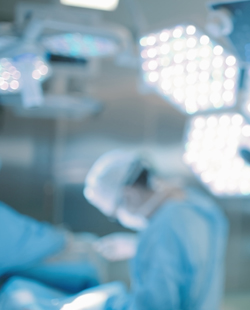Frequently Asked Questions
A surgical sperm recovery is required wherein there are no sperm present in the ejaculate, which is the seminal fluid released from the penis during orgasm. The condition is known as azoospermia and is largely caused by a blockage of the reproductive tract that causes disruption in the flow of the sperm from the testes. In some other cases, it could be caused due to difficulties in sperm production. Thus, in case of azoospermia there is still a possibility of the man being able to father a child, for which a surgical retrieval of the sperm becomes necessary.
A surgical sperm recovery is required wherein there are no sperm present in the ejaculate, which is the seminal fluid released from the penis during orgasm. The condition is known as azoospermia and is largely caused by a blockage of the reproductive tract that disrupts the flow of the sperm from the testes. In some other cases, it could be caused due to difficulties in sperm production. Thus, in the case of azoospermia there is still a possibility of the man being able to father a child, for which a surgical retrieval of the sperm becomes necessary.
The basic goal of surgical sperm retrieval is to extract sperm from the man to fertilize the eggs in the IVF cycle. Consequently, the fertility specialists also look for the best quality sperm available and obtain enough quantity of it to be used for fresh fertilization and freezing purpose. Finally, the surgeon will also look to take sufficient precautions for protecting the structural integrity of the reproductive tract and the testicles.
Surgical sperm retrieval can be done through the skin, or in some cases, an incision may be required. This is known as either a percutaneous or open procedure. In some cases, the retrieval can be achieved via an aspiration, while a tissue sample may have to be extracted in others. The location of the retrieval site also varies from individual to individual, such as – testicle, epididymis, or vas deferens. Finally, the extraction process involves either a microscopic retrieval or a conventional retrieval.
Each of the methods mentioned above involved in the surgical retrieval of sperm can be evaluated and applied based on the needs and conditions of the patient. Also, each of these will have various implications – pros & cons – that must be weighed in the context of infertility and the patient concerned.
There needs to be a thorough and complete evaluation of both partners before the surgical retrieval is planned and attempted. A semen analysis is conducted to check for the underlying condition, and a physical examination of the individual must also be done. In some cases, the doctor could also suggest a testicular biopsy to ensure that the exact cause of azoospermia is ascertained before a surgical procedure is attempted.
This will be a decision based on the discussion of the fertility expert and the urologist. In some cases, fresh sperm may be required and used in the fertilization process right away, and in some cases, the same may be frozen for later use.
Non-surgical sperm retrieval is possible for those suffering from anejaculation or retrograde ejaculation, wherein ejaculation can be induced. The semen is then collected. Via, two possible methods:
Penile Vibratory Stimulation (PVS)
Penile vibratory stimulation is accomplished using a special vibrator that is placed at the tip of the penis. The penis is then stimulated for the ejaculate, and this is then collected to retrieve sperm.
Electroejaculation (EEJ)
The electroejaculation method uses a probe that sends electrical energy to the prostate and seminal vesicle. This is a method used for men with injuries and who do not have any sensation. However, even those men who have normal sensation can opt for this procedure under general anaesthesia.
These are different types of sperm retrieval, including – Percutaneous Epididymal Sperm Aspiration (PESA), Testicular Sperm Aspiration (TESA), Testicular Sperm Extraction (TESE), Micro epididymal Sperm Aspiration (MESA) and Microdissection TESE (micro TESE). The process of sperm extraction and implantation involves three steps – evaluation, extraction, and implantation. The evaluation is to determine the cause of the infertility and arrive at the appropriate procedure for extraction of the sperm. Extraction involves the actual retrieval of the sperm, while insemination takes place either via the IUI or IVF modes.
- Testicular sperm aspiration (TESA)
TESA is a procedure prescribed for men who are participating in an IVF/ICSI cycle. Performed under local anaesthesia involves using a needle inserted into the testicle while a tissue sample/sperm is aspirated. This is usually for men suffering from obstructive azoospermia. - Percutaneous Epididymal Sperm Aspiration (PESA)
PESA involves the use of needle and syringe technique for a needle biopsy and is used for men participating in an IVF/ICSI cycle. This procedure is useful for those with obstructive azoospermia caused by a previous vasectomy or infection. The procedure is performed under local anaesthesia. - Testicular sperm extraction (TESE)
In the case of TESE, the testicle is surgically opened to extract a larger sample of tissue and retrieve the sperm. Sperm extracted during this procedure is usually cryopreserved for future IVF/ICSI. - Micro epididymal Sperm Aspiration (MESA)
Micro epididymal Sperm Aspiration is a procedure prescribed for men with vassal or epididymal obstruction. The sperm extracted are largely cryopreserved for future IVF/ICSI. This procedure allows for an extensive collection of mature sperm when compared to aspiration techniques. Thus, it is now a more preferred retrieval method for men with congenital bilateral absence of the vas deferens. - Microdissection TESE (micro TESE)
MicroTESE has replaced TESE as the preferred form of sperm retrieval for men with no sperm in their ejaculate. The procedure is performed under general anaesthesia and has improved sperm retrieval rate. This is considered a safer procedure as less testicular tissue is removed, and patients usually choose to cryopreserve their sperm for future IVF/ICSI.



